- 0755-21675210
- acdrive@micno.com.cn
2021-12-02
Abstract
This article analyzes the technology and reliability requirements of the blast furnace fan, and introduces the realization of high voltage frequency conversion technology in the blast system of smelting blast furnace by the application example of MICNO high voltage frequency converter in the smelting blast furnace fan of Lianyungang Beigang Nickel Industry Co., Ltd. Examples have proved that the frequency conversion technology has a very good application prospect in energy saving and consumption reduction, and in improving the level of automation control.
Keywords: high voltage frequency conversion technology, blast system of smelting blast furnace, energy saving.
Jiangsu Lianyungang Beigang Nickel Industry Co., Ltd. has a total investment of 340 million yuan and an annual output of 100,000 tons of nickel-iron alloys, 35,000 tons of nickel-iron alloy long proximate matters and castings and forgings. After being put into production, it can achieve annual sales revenue of 1 billion yuan and profits and taxes of nearly 300 million yuan. The plant has currently achieved the leading position in the same industry in China in terms of process equipment, measurement and testing, dust removal and environmental protection, workshop and greening levels.
Modern nickel production methods mainly include fire method and wet method. According to the difference between the two main types of nickel-containing minerals in the world (nickel-containing sulfide ore and oxide ore), the smelting treatment methods are different. At present, nickel-containing sulfide ore is mainly treated by fire method, and metal nickel is obtained by smelting copper, nickel and sulfur and blowing the nickel ore concentrate in the reverberatory furnace of concentrate roasting (electric furnace or blast furnace) before electrolysis. Oxidized ore is mainly nickel-containing laterite, which is of low grade and is suitable for wet processing; the main methods are ammonia leaching and sulfuric acid. The fire treatment of oxide ore is the nickel-iron method. Modern nickel production methods mainly include fire method and wet method. According to the difference between the two main types of nickel-containing minerals in the world (nickel-containing sulfide ore and oxide ore), the smelting treatment methods are different. At present, nickel-containing sulfide ore is mainly treated by fire method, and metal nickel is obtained by smelting copper, nickel and sulfur and blowing the nickel ore concentrate in the reverberatory furnace of concentrate roasting (electric furnace or blast furnace) before electrolysis. Oxidized ore is mainly nickel-containing laterite, which is of low grade and is suitable for wet processing; the main methods are ammonia leaching and sulfuric acid. The fire treatment of oxide ore is the nickel-iron method.
1. Introduction to the process requirements of the user's smelting system
The main processes for smelting nickel sulfide concentrate are as follows:
(1) Smelting.
After the nickel concentrate is dried and desulfurized, it is sent to the smelting blast furnace for smelting. The purpose is to convert the copper and nickel oxides into sulfides to produce low matte nickel (copper-nickel matte) and gangue slagging. The results are low matte nickel.
(2) Blowing of low matte nickel
The purpose of blowing is to remove iron and a part of sulfur to obtain high matte nickel (nickel high sulfur) containing 70% to 75% of copper and nickel instead of metallic nickel. The converter smelting temperature is higher than 1230℃, due to the low matte nickel grade, the general blowing time is long.
(3) Grinding and floating
After the high matte nickel is finely ground and crushed, it is separated by flotation and magnetic separation to obtain a nickel concentrate containing 67% to 68% nickel. At the same time, copper concentrate and copper-nickel alloy are selected to recover copper and platinum group metals respectively. Nickel ore concentrate is melted by reverberatory furnace to obtain nickel sulfide, and then sent to receive electrolytic refining or reduction smelted in the electric furnace (or reverberatory furnace) to obtain crude nickel and then receive electrolytic refining.
(4) Electrolytic refining
In addition to copper and diamonds, crude nickel also contains gold, silver and platinum group elements, which require electrolytic refining and recovery. Unlike copper electrolysis, diaphragm electrolysis cell is used here. Crude nickel is used as the anode, the cathode is the nickel starter piece, and the electrolyte is a mixed solution of sulfate and chloride. After energization, nickel is deposited on the cathode, and platinum group elements enter the anode slime and are separately recovered.
The main technological characteristics of the blast furnace fan are as follows:
The blast furnace fan is the most important power equipment of the blast furnace. It not only directly provides the oxygen required for blast furnace smelting, but also provides the gas power required to overcome the resistance of the blast furnace stock column. Blast furnace smelting requires that the fan can supply a certain amount of air to ensure the combustion of a certain amount of carbon; the required air volume is not only proportional to the furnace capacity, but also related to the strengthening degree of the blast furnace, generally according to the air volume of the unit furnace capacity of 2.1~2.5m3/min. However, considering the development of production, many blast furnaces are equipped with fans with a capacity greater than this ratio. Therefore, the inlet air door and outlet vent valve are generally used to control the air volume and pressure, and to prevent the fan from surging.
Due to the loss of the air door, the low efficiency of the fan, and the huge loss of air for the blast furnace fan, the energy-saving space for the transformation of the high voltage frequency converter is huge. However, as the blast furnace fan is a key equipment for blast furnace production, the motor has a large power capacity and requires continuous operation, the interruption of operation in the blast furnace production, especially when nickel water is discharged, will cause slag filling accidents, resulting in blast furnace blockage, production shutdown, and increase in coke ratio, which will result in great economic losses. Therefore, there are very few transformations of high voltage frequency conversion on blast furnace fans. The main reason is that users have doubts about the operational reliability of high voltage frequency converter equipment.
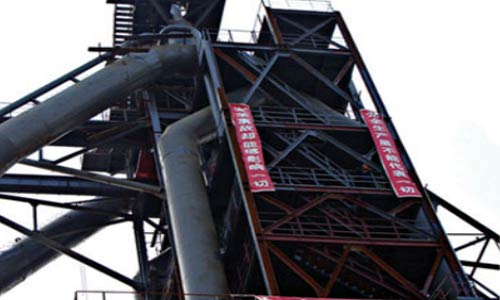
Picture of the blast furnace
The blast furnace fan originally used string water resistance for start control, and the air volume and pressure were adjusted through the inlet air door and outlet duct air door of the fan. After rigorous technical comparison and technical application investigation, the multi-unit series high-high form HE1000 series high voltage frequency converter independently developed and produced by Shenzhen MICNO is used to conduct frequency conversion speed control and energy-saving transformation of a 1600kW blast furnace fan.
1. Technical characteristics of MICNO HE1000 series high voltage frequency converter
In addition to the functions of high voltage frequency converters of general manufacturers, the HE1000 series frequency converters provided by Shenzhen MICNO also have the following characteristics.
1) It has strong functions and can meet different working conditions
The HE1000 series high voltage frequency converter adopts the ingenious combination of DSP system and programmable system, and the control system is highly integrated. The equipment and components mainly adopt imported devices, which have completed the functions of general high voltage frequency converters. It has more than 300 function codes and the functions such as starting characteristic and running mode can be set differently according to the on-site working condition. The HE1000 series high voltage frequency converter has a standard RS485 interface, which can be connected to the DCS through the RS485 communication interface (using a standard communication protocol), or it can be connected to the DCS system through hard wiring. A variety of interface options allow the DCS system to conveniently monitor the frequency conversion speed control system. Different parameter settings can also be carried out to meet various working conditions on site.
2) Comprehensive protection function
The power unit of the HE1000 series frequency converter has as many as 11 types of fault protection; the main control system adopts the great combination of DSP + PFGA, and in terms of the electrical part, there is a comprehensive test on the output voltage, output current, input voltage, and input current. More than two dozen super comprehensive protection functions are available for the power supply and motors of frequency converter in regard to over-voltage, over-current, overload, under-voltage, temperature, etc. Moreover, important protection settings can be parameterized according to different working conditions on site. The built-in lightning overcurrent protection device effectively improves the equipment protection function and system protection function, and can fully guarantee the safe operation of the power supply and the motor.
3) Comprehensive parameter record
The HE1000 series high voltage frequency converter displays a number of operating parameters and process variables, including detection and display of the temperature and bus voltage of each module. It has fault, accident display and recording functions, and self-diagnosis function. The location information can be uploaded to the DCS system through communication. When abnormal situation occurs, the status of the frequency converter is comprehensively recorded, so that on-site personnel can solve the problem more accurately and quickly.
4) Maximum voltage and current redundancy design
The HE1000 series of high voltage frequency converters produced by Shenzhen MICNO are based on safety, reliability and long service life as the primary design principles. They use 1700V high voltage IGBTs, 9-level or 6-level series, and the voltage margin is about 2.0 times. The power device voltage safety design has a high redundancy.
5) The function of automatic tracking of motor speed
During the process of the main power bus switching (within 10 seconds) of the HE1000 series high voltage frequency converter, the frequency converter can automatically track the motor speed. When the main power source is restored, the frequency converter will automatically run to ensure the safe and reliable operation of the unit.
6) Power module automatic bypass technology
The module automatic bypass technology improves the stability of the system. The HE1000 series high voltage frequency converter adopts the power module automatic bypass technology, which can bypass the faulty module within 1ms. The frequency converter can be derated and can run for a long time. It will be halted when appropriate.
7) Good adaptability to voltage fluctuations
The HE1000 series high voltage frequency converter fluctuates within ±15% of the grid voltage, and the frequency converter can output at full load; when the grid voltage drops to 65% of the rated voltage for a short period of time (30 seconds), it can continue to service in a derated capacity without protection.
8) The most effective electromagnetic interference solution
In terms of module design, HE1000 series high voltage frequency converters exclusively adopt back-in and front-out design schemes; in terms of structure and electrical aspects, electromagnetic anti-interference measures are fully considered, especially the core control panel, which most effectively guarantees the reliable operation of the frequency converter.
9) Reasonable cooling system
The power adopts independent cooling air ducts, and the system focuses on heat dissipation. The heat dissipation performance is good. The temperature rise does not exceed 25℃ in full load and long-term operation. A good heat dissipation system can ensure the high reliability of the frequency conversion device and extend the service life of the internal components of the frequency conversion device.
10) Modular design
The HE1000 series frequency converters follow the modular design concept. The power unit adopts a modular structure. The structure and configuration of the same power units are completely the same, and they can be interchanged very conveniently, which is conducive to the standardization of production and maintenance.
11) The simplest operation and the fastest maintenance
The HE1000 series high voltage frequency converter has a user-friendly interface design with a simple and clear interface; it is easy to operate and adopts a drawer-type module design, which only takes 5 minutes to replace the module; and the filter is easy and fast to replace.
2. The configuration of frequency converter
According to the on-site rated parameters and actual requirements, combined with the application of our company's HE1000 series high voltage frequency converter in other projects, our company configures the following frequency converter, and its main parameters are as follows:
| Serial number | Items | Fan |
| 1 | Frequency converter model | HE1000-1600G-T16 |
| 2 | Rated capacity | 1600kVA |
| 3 | Rated voltage | 10KV |
| 4 | Rated current | 112A |
| 5 | Configurable motor | Ordinary asynchronous motor 1600kW/10KV |
| 6 | Control mode | one frequency converter drags two fans and bypasses manually |
3. Drag mode of frequency converter
According to on-site control requirements, combined with the application of our company's HE1000 series high voltage frequency converters in other projects, the drag mode of our company's HE1000 frequency converter adopts the scheme that one frequency converter drags two fans and bypasses manually. The frequency converter has a speed tracking function. The one-time system is shown in the figure below:
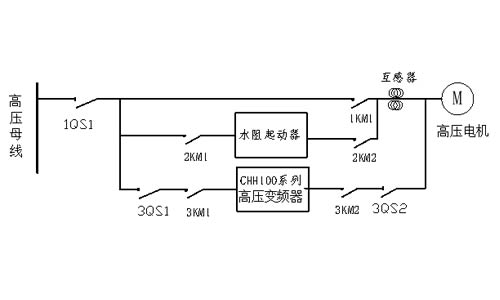
高压母线high voltage bus 水阻起动器water resistance starter 互感器transformer 高压电机high voltage motor CHH100系列高压变频器CHH100 series high voltage frequency converter
The diagram of HE1000 series high voltage frequency conversion system
This program has two sets of drag control methods: one is controlled by frequency converter, and the other is controlled by water resistance after the frequency converter fails. The program is designed in strict accordance with the "five prevention" interlocking requirements. The high voltage vacuum contactors 3KM1, 3KM2 that the frequency converter inputs and outputs and high voltage vacuum contactors 1KM1, 2KM1, 2KM2 of the water resistance startup system are interlocked. No matter which control method is adopted, the power supply of the other control method is cut off, which can fully ensure the safe operation of the frequency conversion speed control system. The high voltage isolation switches 3QS1 and 3QS2 that the frequency converter inputs and outputs are used for high voltage isolation during frequency converter maintenance.
Advantages of automatic bypass scheme:
² The input and output of the frequency converter are designed with disconnectors, which is convenient for the maintenance and repair of the frequency converter.
² Easy to operate: it can be operated on site or remotely, and it is easy to realize automatic control.
4. The control mode of frequency converter
(1) The HE1000 frequency converter provided by us has three control methods:
① The method of given DCS analog quantity.
The electricians on duty judge by the emission load of smoke and dust in the boiler or remotely automatically detect the emission load of smoke and dust in the boiler so as to manually or automatically adjust the frequency given signal, and meet the requirements of the fan on air volume and air pressure.
② The frequency converter can be used for multi-speed control mode through remote switch.
The electricians on duty judge by the emission load of smoke and dust in the boiler or remotely automatically detect the emission load of smoke and dust in the boiler so as to manually adjust the remote switch signal, and meet the requirements of the fan on air volume and air pressure.
③ In the control state of this cabinet, the number of revolutions can be manually set on the monitoring interface of the frequency conversion device on the cabinet. Other remote control setting methods are invalid. In the remote control state, the control setting mode of this cabinet is invalid.
The monitoring computer of the remote operation console is used on the scene to set the frequency or speed. When the high voltage frequency converter is running with frequency conversion, the user can adjust the frequency of the frequency conversion system of the fan in the control room according to the actual pressure demand in the nickel smelting process to meet the requirements of the working conditions. The blast furnace fan has a wind pressure requirement, so the operating frequency is generally above 40Hz, and the lower limit frequency of 30Hz is set in the control system, and the blow off valve is still used when the material may be surged to avoid the fan entering the surge zone due to too small air volume.
(2) The high voltage frequency converter has remote and local control functions.
During local control, the high voltage frequency converter can be manually started and stopped on the spot through the touch screen on the control cabinet of high voltage frequency converter, and the motor speed and frequency can be adjusted. The remote control is placed in the control room, equipped with a console and a host computer, which are operated and controlled by an electrician. The electrician of the upper computer can know the operation of the equipment at any time, and the simple remote operation of the high voltage frequency converter can be realized through the console. The electrician can freely select the "manual/automatic" speed control operation of the high voltage frequency converter according to the working conditions.
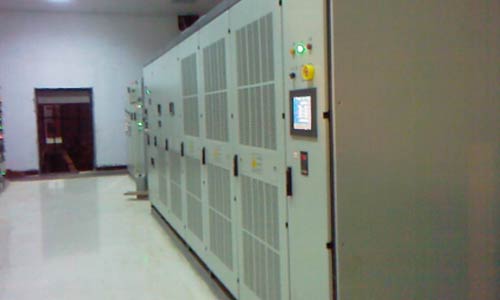
According to the principle of fluid mechanics, the relationship between the shaft power P and the air volume Q and the air pressure H of the fan driven by an induction motor is:
When the motor speed changes from n1 to n2, the relationship between Q, H, P and the speed is as follows:
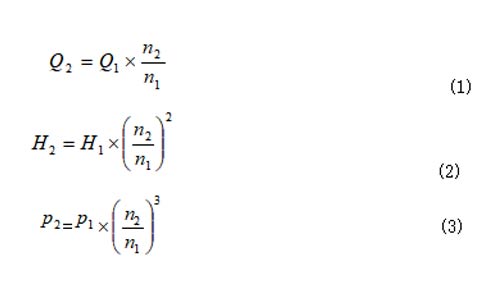
It can be seen that the air volume Q is proportional to the speed n of the motor, and the required shaft power P is proportional to the cube of the speed. Therefore, when 80% of the rated air volume is required, by adjusting the motor speed to 80% of the rated speed, that is, adjusting the frequency to 40Hz, the required power will only be 51.2% of the original, and the system operating point changes as shown in the figure below:
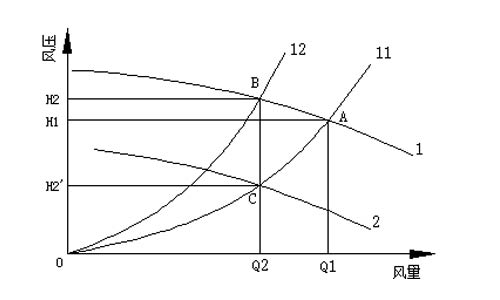
风压Wind pressure 风量 Air volume
Schematic diagram of operating points of frequency conversion speed control system
Analyze the energy-saving effect of using frequency conversion speed control system from the characteristic diagram of the above figure. Under rated conditions, the system works at point A. When the required air volume decreases from Q1 to Q2, if the power frequency is running and the flow rate decreases, the system pressure will increase, and the system will work at point B. If the fan is adjusted by a frequency converter, when the system wind pressure meets the requirements, the system will run at point C. The ratio of the area of the X-axis and Y-axis corresponding to point C and the area of the X-axis and Y-axis corresponding to point B is the ratio of the power consumed by frequency conversion to the power consumed by the industrial frequency, and other losses in the system need to be considered at the same time.
The energy-saving benefits are calculated as follows:
Measured energy saving comparison
On December 6, 2009, at the site of the smelting blast furnace blowing system of Lianyungang Beigang Nickel Industry Co., Ltd., Jiangsu, the data measured by the measuring instrument are as follows:
| Regulation method | Input current | Input voltage | Input power factor | Operating power | Daily power consumption |
| Valve adjustment | 82.23A | 9970V | 0.76 | 1079.16KW | 25899.84 degrees |
| Frequency conversion adjustment | 53.56 | 9970V | 0.96 | 887.88KW | 21309.12 degrees |
The test results:
The energy saving comparison of 1600KW/10KV fan in valve adjustment and frequency conversion adjustment is as follows:
| Name | Data |
| Power saving rate | 17.77% |
| Daily energy saving power | 4590.72 degrees |
| Annual energy-saving electricity | 1,377,200 kWh |
| Annual power saving benefit | 826,300 yuan |
It can be seen that after investing in a HE1000 series frequency converter produced by Shenzhen MICNO Electric Co., Ltd., the project can save about 820,000 yuan in electricity bills throughout the year. In addition, because the power factor of the HE1000 series frequency converter produced by Shenzhen MICNO Electric Co., Ltd. can reach more than 0.95, which is greater than the motor power factor of 0.89, a large amount of reactive power is reduced. In addition, the soft start of the motor can be realized, which can avoid the impact on the motor insulation caused by the impact of high current start, reduce the maintenance of the motor, save the maintenance cost, and greatly extend the service life of the motor. Besides, it reduces the labor intensity of the operating personnel and is well received by the operating personnel and maintenance personnel.
According to the installation and use of our company's frequency converters in various fields, we conclude that frequency converter transformation has the following advantages:
(1) The installation is simple, that is, the frequency converter is inserted between the original switch cabinet and the motor, and the original wiring is not changed.
(2) The operation is convenient, and the frequency converter operation only has simple startup, shutdown and frequency adjustment.
(3) It can carry out stepless speed control with a wide speed control range, high speed control precision and strong applicability.
(4) Perfect protection function, low failure rate, smooth start of the fan, low starting current and high reliability.
(5) The motor does not need long-term high-speed operation, the working current is greatly reduced, and the power saving effect is significant.
(6) Since the frequency converter replaces the valve speed control, the defects of high failure rate of machinery and pressure are eliminated, and the equipment maintenance cost is reduced.
(7) The vibration and noise of the motor are significantly reduced, and the temperature of the bearing is also greatly reduced.
(8) The AC variable frequency speed controller is welcomed by users for its strong applicability, high reliability, and easy operation and use. It is used in speed control, power saving, soft start, and has great practical value for enterprises.
The energy-saving effect of the high voltage frequency conversion device is obvious. After the frequency conversion speed control system is adopted, the soft start of the motor is realized, the service life of the motor is prolonged, and the vibration and wear of the pipeline are also reduced. All in all, the multi-unit series high-high form HE1000 series high voltage frequency converter independently developed and produced by Shenzhen MICNO Electric Co., Ltd. has been successfully applied in the smelting blast furnace blowing system of Lianyungang Beigang Nickel Industry Co., Ltd., Jiangsu. The advancement and reliability of this series of frequency converters have been confirmed by many industrial applications.
References:
[1] Guidelines for energy-saving transformation of fans and pumps (edited by the Department of Comprehensive Utilization of Resources and Energy of the State Economic and Trade Commission).
[2] A guide to energy-saving technology of AC motor frequency conversion speed control system (edited by the Energy Conservation Information Communication Center of the State Economic and Trade Commission).
[2] "HE1000 Series Instruction Manual"